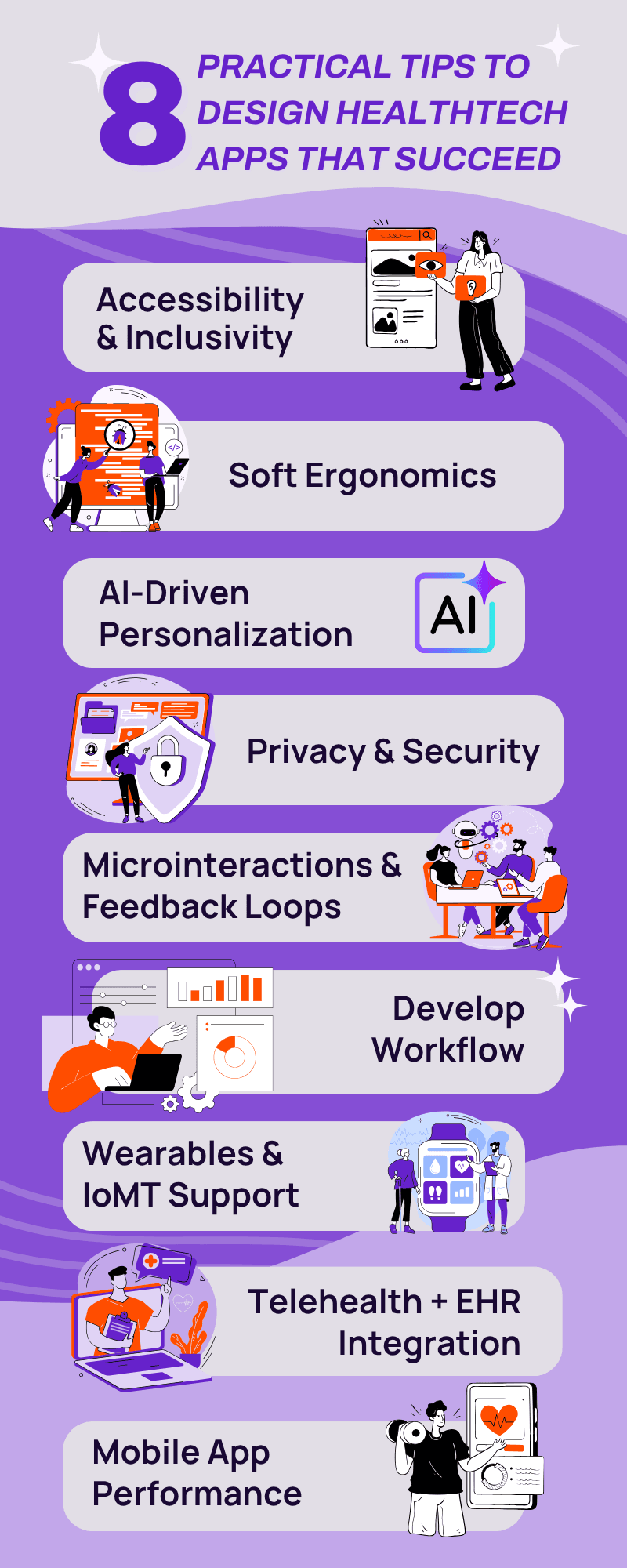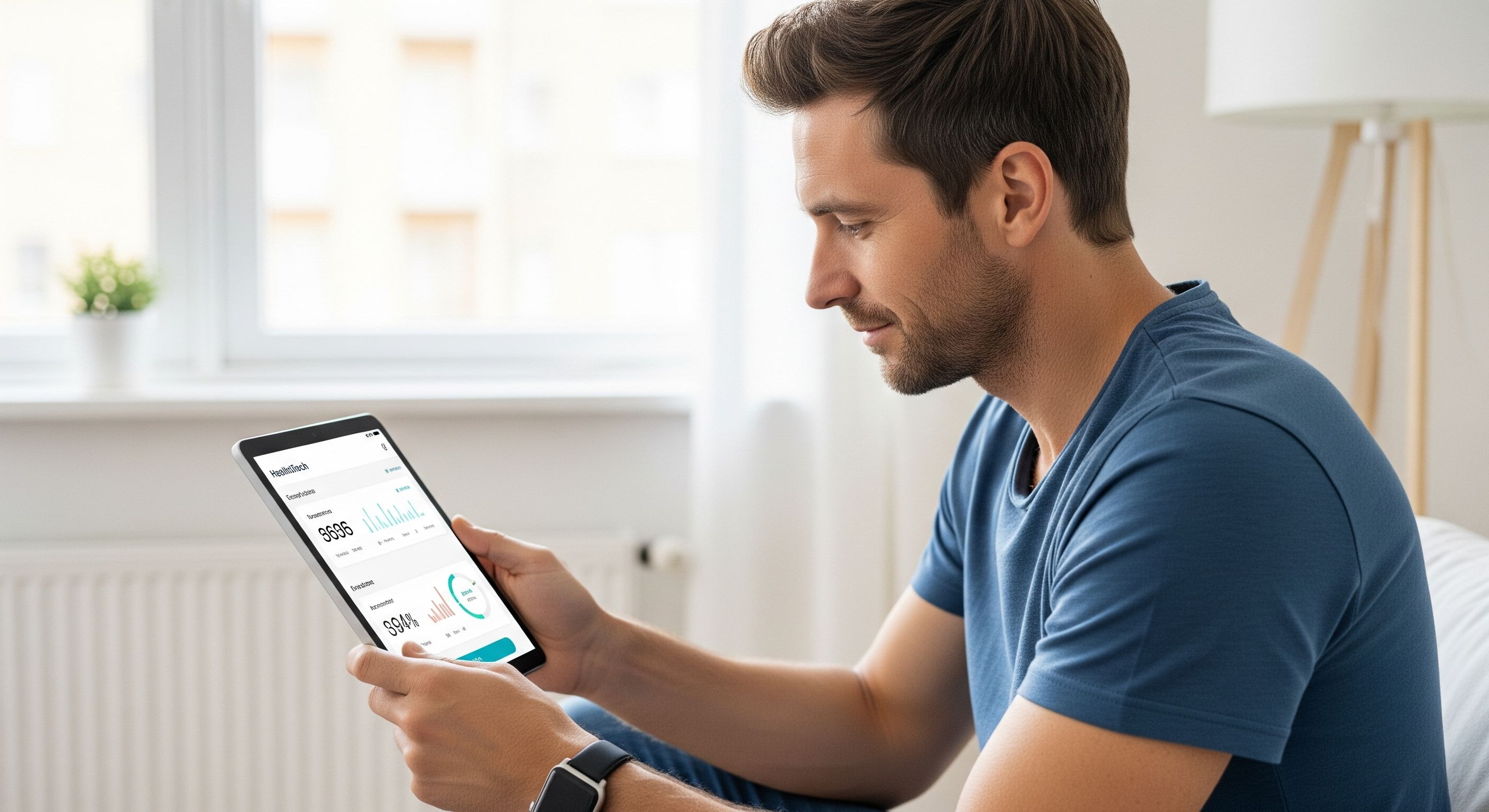HealthTech apps refer to technologies such as fitness trackers, telemedicine platforms, wellness software, and diagnostic solutions. These solutions help patients receive better care, and healthcare professionals, such as doctors and nurses, deliver it.
Considering their importance, HealthTech apps should be thoughtfully designed to ensure they are user-friendly, secure, accurate, and accessible. This ensures that these solutions are used for medical processes, such as diagnosis and monitoring.
However, it is easier said than done.
Health app designs are fundamentally distinct from those of other apps. Medical and healthcare platforms handle personal and sensitive data and directly affect the well-being of the user.
Hence, it’s quite easy to make mistakes when developing a custom HealthTech application.

You may have encountered healthcare apps that have confusing interfaces, misleading features, and questionable privacy. Patients often abandon such solutions quickly, diminishing their impact on healthcare and wellness.
So, how do you design a HealthTech app that hits the mark? Over the years, we’ve designed numerous successful health apps, including AllDayDr and Remedy Social, for our clients.
In this article, let’s look at eight tips that’ll help you design HealthTech apps that patients actually want to use.
1. Prioritize Accessibility and Inclusivity
Healthcare apps’ users come in all sizes. They may have visual, auditory, and motor impairments. Additionally, many can come from different linguistic and cultural backgrounds.
Hence, your healthcare app design should ensure people of all abilities and ages can access the tool without much hassle.
You can design an inclusive and accessible health app by focusing on the following:
- Provide the app in multiple languages
- Include readable font sizes and high-contrast color palettes
- Receive input in various modes, such as text and voice
Development teams should start with empathy-driven research that puts the patients’ needs and preferences at the center. Create multiple personas with unique abilities and requirements.
It can be advantageous to use established standards like the Web Content Accessibility Guidelines (WCAG) to accelerate healthcare software development.
Before the public rollout, the HealthTech app should undergo usability testing with diverse user groups. Developers can integrate this practice during the development phase to ensure agility.
While these tips help you design feature-rich HealthTech apps, it’s equally important to follow proven healthcare UI/UX best practices to ensure accessibility, compliance, and user trust.
2. Apply Soft Ergonomics
Soft ergonomics refers to the cognitive and emotional ease of using a health app.
Traditional or physical ergonomics focuses on the tangible aspects of the tool, such as the arrangement of menus. Soft ergonomics ensures that patients receive a delightful experience.
This aspect is essential for HealthTech app design because users often access these solutions in stressful conditions and environments. Hence, it is key that your healthcare solution offers calmness and emotional comfort to the user.
A health app with good soft ergonomics doesn’t overwhelm the user with too many options or functionalities on a single screen and allows them to find value quickly. The platform should display identical responsiveness on all devices.
When designing a HealthTech app, keep the layout clean by only showing relevant information at a time and ensuring logical navigation flows. This is essential to minimize cognitive load, which delivers a delightful experience to your users.
Another effective way is to provide data or instructions incrementally, rather than all at once, in simple, conversational English (or the preferred language). It is better to avoid complex medical terminologies and jargon if it is geared toward everyday users.
To learn how to tangibly design soft ergonomic features, conduct contextual user research, and test multiple wireframes. You can easily discover what works and what doesn’t with your target audience, streamlining the healthcare app development process.
3. Integrate AI-Driven Personalization
Machine learning (ML) and artificial intelligence (AI) can be quite effective in designing a personalized HealthTech app for your customers. These technologies learn from your users’ behavior to customize their in-app experiences.
The advanced algorithms can observe how your patients and customers leverage the health apps. Then, through reinforcement learning, they can meet their unique requirements, such as offering tailored diet recommendations based on allergies.
AI can be further integrated through chatbots, dynamic dashboards, contextual notifications or nudges, and content recommendations. Over time, your users will view your well-designed healthcare app as a trusted partner, boosting adoption.
For example, when a user managing diabetes gets custom meal plans or blood sugar reminders, they should be able to set and achieve their health goals easily. With the right compliance protocols, the entire process will feel tailored yet unobtrusive.
To implement this thoughtful healthcare app design tip, you need to determine the relevant medical data points that drive the desired outcomes. For instance, if your tool offers custom meal plans, it should collect information about the user’s food preferences and health goals.
It can be advantageous to approach this on a feature-by-feature basis. After listing all the data points needed for all the AI-powered functionalities, you can start designing the HealthTech app.
4. Ensure Patient Privacy and Security
HealthTech apps contain sensitive data, including medical histories, personal identifiers, and patient and user communication records. It is your responsibility as the vendor to protect your users’ private information from unauthorized agents.
A strong focus on privacy and security from the start prevents costly fixes down the line, ensures compliance with laws (e.g., HIPAA), builds user trust early, and prevents potential data breaches.
Furthermore, it enables you to develop and scale the app without worrying about regulations when your customers’ needs grow.
Implementing safety features, such as multi-factor authentication (MFA), encrypted data storage and transmission, Know Your Customer (KYC) verification, and clear privacy policies, is critical for ensuring patient privacy and security.
You can give more control to your users by incorporating privacy-first defaults. This ensures that users opt in to data sharing if they want. Such health app design principles earn customer confidence in the platform for your brand.
To put it into practice, conduct regular vulnerability assessments and penetration testing based on regulatory standards. Moreover, you can offer transparency dashboards to show users which data points you collect and how you use them.
5. Design Microinteractions and Feedback Loops
Microinteractions are small, functional design elements in HealthTech apps that guide users through various actions. Feedback loops provide real-time responses to users’ actions, helping them understand the outcomes of specific steps they take.
For instance, an in-app success message with haptic feedback can educate your customer that they are using the healthcare app in the correct way, reinforcing behaviour.
Both microinteractions and feedback loops enhance health app design by improving usability and offering motivation. These design elements make your platform feel “alive” and responsive while subtly shaping user habits.
This is essential for ensuring that each patient or customer consistently receives immediate value over time. Consequently, they will return and recommend your HealthTech application to others.
You can incorporate this by defining user actions that require reinforcement or further clarity to drive certain outcomes. Then, collaborate with UX designers to define motion and feedback standards that align with your app’s tone and branding.
Beyond security measures, patient confidence depends on transparency, reliability, and ethical design. Here are some proven strategies to build trust in HealthTech apps that ensure long-term adoption.
6. Include Support for Wearables and IoMT
Modern healthcare apps collect biological and medical data through wearables and Internet of Medical Things (IoMT) tools. Devices like fitness trackers, smart insulin pens, and remote ECG monitors collect and transmit health data to HealthTech platforms.
As patients and health-conscious individuals increasingly desire seamless tracking of metrics, such as heart rate, sleep cycles, and activity levels, ensuring rich integrations with wearables and IoMT devices is critical.
When designing HealthTech applications, go with flexible, device-agnostic APIs. These APIs work across devices and platforms without requiring custom code for each operating system or tool, streamlining development.
To keep things simple, you can adopt standard protocols, such as Bluetooth Low Energy (BLE), and health data frameworks like Apple HealthKit or Google Fit. This will build a solid foundation for your healthcare solution, enabling easier enhancements in later stages.
The final, and most important, component is accurate data syncing. The sensors in the wearables and IoMT devices should transfer the readings to your health app instantly, making the readings accessible through intuitive dashboards and trend graphs.
7. Connect Telehealth and EHR Data Flows
Telehealth leverages means such as phone calls, video conferencing, and in-app interaction to receive medical care. Doctors and nurses can directly interact with patients and provide consultations, diagnoses, and treatment without in-person visits.
Electronic Health Records (EHRs) refer to the collection of patient data recorded at hospitals and clinics. When integrated with telehealth data collected through HealthTech applications, they can elevate medical services significantly.
Basically, it speeds up information sharing while respecting the privacy and safety of your customer.
Your HealthTech platform should ensure users can join calls, locate medical records, and make payments seamlessly. Additionally, store the information the user provides in a unified database for easier access.
There are several ways you can unify data from telehealth services and EHRs via thoughtful app design. Features such as one-click appointment bookings and easy access to personal health data and medical records can make your HealthTech app impactful.
Moreover, make it easy for users to upload documents, access prescriptions, and view visit summaries. You can help your users access these features through soft ergonomic features such as haptic feedback. This will let them know if they are headed in the right direction in a subtle manner.
An effective way to integrate telehealth data and EHR records is to select a widely used EHR system, such as Epic or Cerner. Remember to use secure APIs and adhere to HL7/FHIR standards to ensure compliance. Protecting your users’ sensitive medical information is paramount to earning trust and loyalty.
8. Emphasize Mobile App Performance
Design for smartphone users first.
Users are more likely to use mobile devices, such as smartphones and tablets, due to ease of use. In the US alone, an estimated 92.4 million smartphone users will sign up for health apps in 2025.
If your HealthTech app is responsive, fast, and useful, it will be appreciated by your audience and allow you to tap into a larger audience.
Additionally, you can include some offline functionality to ensure uninterrupted services during emergencies and network issues. Here, it’s key to protect users’ data on-device during data sync delays. The local encryption technology AES-256 is reliable. Other technologies include app sandboxing, obfuscation of sensitive data, and storing data in keychains or keystores.
These HealthTech app design practices can enhance stickiness and improve user satisfaction, ultimately driving daily engagement and fostering long-term retention.
A good way to be mobile-first is to adopt a touch-first design approach. It translates to large tap targets, minimal text input, and responsive layouts. This decreases the cognitive load when using your health app.
When testing, consider various usage conditions. Use the app when outdoors, the device has poor cellular connectivity, and the battery is low. Run the newly designed HealthTech app in various smartphone models, especially older ones, to test responsiveness.
SoluteLabs: Your HealthTech App Development Partner!
Improving UX to boost adoption and retention requires a multi-pronged approach for organizations and companies in the healthcare sector. Optimize every health app design aspect, from accessibility and AI to microinteractions and compliance.
Doing that in-house can be tricky. Managing the app development workflow, team members, testing, and public rollout can be difficult.
Using SoluteLabs’ battle-tested custom HealthTech app development services will ensure your platform hits the mark.
Our team builds compliant, AI-powered, and intuitively designed health apps to help you deliver excellent care to your patients and users.
Contact us today and we’ll get you started.







